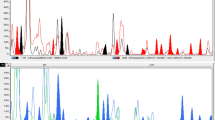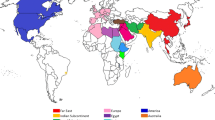Abstract
Amplified fragment length polymorphism (AFLP) analysis was used to determine genetic relationships among 32 accessions of the species Stylosanthes humilis, representing 26 and 6 accessions of Mexican and South American origin, respectively. Seven AFLP primer pairs generated a total of 111 polymorphic bands with an average of 15.8 polymorphisms per combination and a polymorphic information content ranging from 0.89 to 0.79. Cluster analysis and principal coordinates analysis of the calculated similarity matrix clearly separated all the Mexican accessions, with one exception, from the accessions of South American origin. The observation of differentiation of these two main groups by AFLP analysis is highly congruent with previous studies based on morphological descriptors, cross-hybridization experiments, and chloroplast DNA sequence analysis, and may suggest that both groups evolved separately due to geographical isolation in the past, resulting in the existence of at least 2 principal gene pools. Within the Mexican collection, three groups were recognized, each corresponding to a geographical region with a low within-group and a high between-group genetic variability. Although most Mexican accessions formed one major group, one accession clustered with the South American gene pool. These findings show that Mexico may contain unique sources of S.humilis and therefore would merit attention for conservation and maintenance of S. humilis germplasm. Also, these results demonstrate that AFLP analysis is an efficient method for assessing genetic diversity among S. humilis accessions.
Similar content being viewed by others
References
Bassam, B.J., G. Caetano-Anollés & P.M. Gresshoff, 1991. Fast and sensitive silver staining of DNA in polyacrylamide gels. Anal Biochem 196: 80–83.
Burt, R.L., 1984. Natural variation in Stylosanthes. In: H.M. Stace & L.A. Edye (Eds.), The Biology and Agronomy of Stylosanthes, pp. 103–124. Academic Press, London.
Curtis, M.D., D.F. Cameron & J.M. Manners, 1995. Molecular evidence that diploid S. humilis and diploid S. hamata are progenitors of allotetraploid S. hamata cv. Verano. Genome 38: 344–348.
Edye, L.A., R.L. Burt, C.H.L. Nicholson, R.J. Williams & W.T. Williams, 1974. Classification of the Stylosanthes collection 1928–1969. CSIRO Div Trop Agron Tech Pap 15.
Gower, J.C., 1972. Measures of taxonomic distance. In: J.S. Weiner & J. Huizinga (Eds.), The Assessment of Populations Affinity in man, pp. 1–24, Clarendon Press, Oxford.
Hill, M., H. Witsenboer, M. Zabeau, P. Vos, R. Kesseli & R. Michelmore, 1996. PCR-based fingerprinting using AFLPs as a tool for studying genetic relationships in Lactuca spp. Theor Appl Genet 93: 1202–1210.
Irwin, J.A.G. & D.F. Cameron, 1978. Two diseases in Stylosanthes spp. caused by Colletotrichum gloeosporioides in Australia, and pathogenic specialization within one of the causal organisms. Austr J Agric Res 29: 305–317.
Kazan, K., J.M. Manners & D.F. Cameron, 1993. Genetic variation in agronomically important species of Stylosanthes determined using random amplified polymorphic DNA markers. Theor Appl Genet 85: 882–888.
King, L.M. & B.A. Schaal, 1989. Ribosomal-DNA variation and distribution in Rudbeckia missouriensis. Evolution 43: 1117–1119.
Koenig, R. & P. Gepts, 1989. Allozyme diversity in wild Phaseolus vulgaris: further evidence for two major centres of genetic diversity. Theor Appl Genet 78: 809–817.
't Mannetje, L., 1984. Considerations on the taxonomy of the genus Stylosanthes. In: H.M. Stace & L.A. Edye (Eds.), The Biology and Agronomy of Stylosanthes, pp. 1–22. Academic Press, London.
Nei, M., 1978. Estimation of average heterozygosity and genetic distance from a small number of individuals. Genetics 89: 583–590.
Paul, S., F.N. Wachira, W. Powell & R. Waugh, 1997. Diversity and genetic differentiation among populations of Indian and Kenyan tea (Camellia sinensis (L.) O. Kuntze) revealed by AFLP markers. Theor Appl Genet 94: 255–263.
Roa, A.U., M.M. Maya, M.U. Duque, J. Tohme, A.U. Allem & M.W. Bonierbale, 1997. AFLP analysis of relationships among cassava and other Manihot species. Theor Appl Genet 95: 741–750.
Rohlf, F.J., 1992. NTSYS-pc: Numerical taxonomy and multivariate analysis system. Exeter Software, Exeter, Setauket, New York.
Schoen, D.J. & A.H.D. Brown, 1991. Intraspecific variation in population gene diversity and effective population size correlates with the mating system in plants. Proc Natl Acad Sci USA 88: 4494–4497.
Schultze-Kraft, R., R. Reid, R.J. Williams & L. Coradin, 1984. The existing Stylosanthes collections. In: H.M. Stace & L.A. Edye (Eds.), The Biology and Agronomy of Stylosanthes, pp. 125–146. Academic Press, London.
Stace H.M. & D.F. Cameron, 1984. Cytogenetics and the evolution of Stylosanthes. In: H.M. Stace & L.A. Edye (Eds.), The Biology and Agronomy of Stylosanthes, pp. 49–72. Academic Press, London.
Tohme, J., D.O. Gonzalez, S. Beebe & M.C. Duque, 1996. AFLP analysis of gene pools of a wild bean core collection. Crop Sci 36: 1375–1384.
Travis, S.E., J. Maschinski & P. Keim, 1996. An analysis of genetic variation in Astralagus cremnophylax var. cremnophylax, a critically endangered plant, using AFLP markers. Mol Ecol 5: 735–745.
Van Campenhout, S., J. Vander Stappen, L. Sagi & G. Volckaert, 1995. Lodus specific primers for LMW glutenin genes on each of the group 1 chromosomes of hexaploid wheat. Theor Appl Genet 91: 313–319.
Vander Stappen J., I. Weltjens, S. Van Campenhout & G. Volckaert, 1999a. Genetic relationships among Stylosanthes species as revealed by sequence-tagged site markers. Theor Appl Genet 98: 1054–1062.
Vander Stappen J., I. Weltjens, F. Munaut & G. Volckaert, 1999b. Interspecific and progeny relationships in the genus Stylosanthes inferred from chloroplast DNA sequence variation. CR Acad Sci III: 322: 481–490.
Vos, P., R. Hogers, M. Bleeker, M. Reijans, T. van de Lee, M. Homes, A. Frijters, J. Pot, J. Peleman, M. Kuiper & M. Zabeau, 1995. AFLP: a new technique for DNA fingerprinting. Nucl Acids Res 23: 4407–4414.
Whitkus, R., M. de la Cruz, L. Mota-Bravo & A. Gomez-Pompa, 1998. Genetic diversity and relationships of cacao (Theobroma cacao L.) in southern Mexico. Theor Appl Genet 96: 621–627.
Williams R.J., R. Reid, R. Schultze-Kraft, N.M.S. Costa & B.D. Thomas, 1984. Natural distribution of Stylosanthes. In: H.M. Stace & L.A. Edye (Eds.), The Biology and Agronomy of Stylosanthes, pp. 73–102. Academic Press, London.
Author information
Authors and Affiliations
Rights and permissions
About this article
Cite this article
Vander Stappen, J., Weltjens, I., Gama Lopez, S. et al. Genetic diversity in Mexican Stylosanthes humilis as revealed by AFLP, compared to the variability S. humilis accessions of South American origin. Euphytica 113, 145–154 (2000). https://doi.org/10.1023/A:1003989505449
Issue Date:
DOI: https://doi.org/10.1023/A:1003989505449




